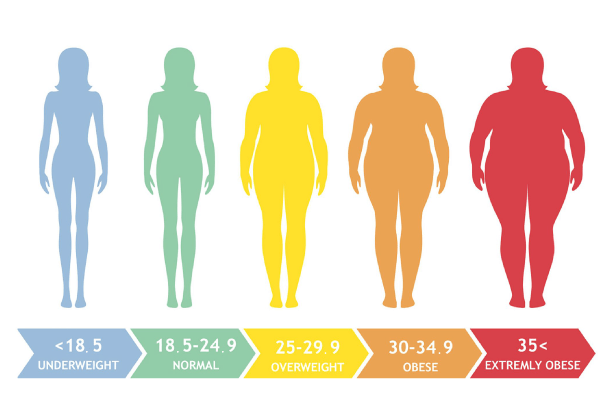Fitness & Exercise, Health, Lifestyle, Weight Loss
BMI Calculator for Men & Women – Understand Your Body Mass
What is Body Mass Index (BMI)?
Body Mass Index (BMI), is the most affordable screening tool used to measure the body fat percentage based on the height and weight of the person.
BMI gives an accurate measurement of body size. It is helpful to determine if the person is of correct weight according to their height.
This inexpensive tool is used by doctors and nutritionists to identify weight-related health problem in adults.
How to use the BMI calculator?
There is no standard weight that should fit every individual. The calculated value of BMI gives an idea of what weight an individual should have as per his/her height.
The BMI calculator takes into account your weight (in kgs) and height (in meters) as per the standard BMI formula.
However, the gender of the person is not taken into account by the BMI calculator. While determining the fat content, it is very important to consider fat distribution since this differs among men and women.
Similarly, other factors like age, body type and body muscle content are also important while determining overall fat per cent. Since these factors are also not considered by BMI calculator, it is not possible to get precise information.
Standard formula to measure BMI
Body Mass Index is the ratio of an individual’s weight in kilograms to the square of height in meters.
Research has suggested that BMI value is directly related to body fat content and consequently, to various metabolic and disease outcomes.
BMI= weight (kg) / [height (m)]2
BMI Interpretation for Adults
The BMI categories take into account various body shapes, giving a healthy weight range for a particular height.
Also, these categories are the same for man and woman of all body types and ages.
| Vegetables | Fruits | Meat Products | Others |
|---|---|---|---|
| Garlic | Apricots | Sausages | Biscuits |
| Onion | Cherries | Chorizo | Cakes and croissant |
| All types of beans | Figs | Wheat bread | |
| Leeks | Grapefruit | Wheat based cereal bars | |
| Peas | Plums | Muffins and pastries | |
| Asparagus | Prunes | Carbonated drinks | |
| Cauliflower | Blackberries and Goji berries | Wine and beer (not more than one glass) |
Interpretation of BMI values

- The low BMI value of 18.5 and less depicts the condition of underweight which means that the affected individual needs to gain weight.
- The BMI value between 18.5-24.9 indicates the healthy range which an individual needs to maintain with a healthy lifestyle, balanced diet and exercise routine.
- The high BMI value between 25-29.9 means that the individual is overweight and needs to lose weight.
- The BMI value of 30 and above is hazardous. Individuals in this category must take immediate steps to reduce their weight to reverse or prevent health-related complications.
Health consequences of high BMI in adults
Researches have established that people with high BMI are at increased risk for many diseases and health conditions including
1. Increased mortality rate
Obese or overweight people face the risk of dying prematurely when compared to people who are of normal weight. Overweight people are highly likely to develop chronic and cardiovascular diseases that can lead to early death. [1]
2. Diabetes
Type 2 Diabetes is a common outcome of being overweight. People who are on the higher end of BMI value are likely to develop Type 2 Diabetes because their cells begin to resist insulin due to excess weight.
The first sign of Type 2 Diabetes is pre-diabetes. This is an indication that if the person does not take steps to reduce the weight, they will develop full-blown diabetes.[2]
3. Hypertension
Another risk factor of being overweight is high blood pressure and Hypertension. When your weight increases, your blood pressure also increases. Studies have shown that even losing five kilograms can improve hypertension. [3]
4. Cardiovascular diseases
A person with a higher BMI can accumulate bad cholesterol (LDL) and have low levels of good cholesterol (HDL). Being overweight is the chief factor behind this.
As mentioned in the previous point, obesity also leads to hypertension. These factors lead to the development of cardiovascular diseases.[4]
5. Osteoporosis
While some studies have shown that fat mass is good for bone mass and health, other studies have revealed that excess fat percentage can be damaging to the bones. However, more research is need on this subject. [5]
4. Stroke
Excess fat tissues cause inflammation which in turn leads to stroke. This blocks the blood flow and ups the risk of blockage.
When you reduce your body weight bring the BMI to normal range, you reduce the risk of developing stroke greatly.[6]
5. Gallbladder diseases
Studies have revealed that an obese person may accumulate cholesterol in their bile which may lead to gallstones. Losing weight can reduce the risk greatly.
However, it is important to note that losing a large amount of weight all of a sudden can also cause gallstone. Therefore it is important to lose weight in a healthy and sustainable manner. [7]
6. Chronic inflammation
Studies have now linked chronic inflammation to obesity. When you overeat, your immune response is increased. This can cause excessive inflammation. Similarly, excess weight also disrupts body metabolism. Reducing weight can keep inflammation at way. [8]
7. Cancer
Several studies have noted that obesity can cause certain cancers like breast, pancreatic, gallbladder, liver, kidney, endometrial cancer etc.[9]
As BMI goes up, the risks of metabolic diseases also increase.
Health consequences of low BMI
Though the major limelight is stolen away by the high BMI, the condition of low BMI is also life-threatening which should be addressed timely. The risks associated with being underweight are:

- Malnutrition
- A decrease in immunity
- Restricted growth and development
- Reproductive issues and increased risk of miscarriage
- Higher mortality as compared to normal BMI
Limitations of BMI
BMI is the most commonly used tool for measuring body weight and it comes with certain limitations too. These limitations include,
- It does not differentiate between muscle mass and fat mass.
- Consider body weight and not body fat percentage.
- Do not take into account age and gender.
- It is not able to reflect the right health status at some life stages like pregnancy, breastfeeding and childhood.
BMI is an inexpensive, easily affordable and understandable tool that can give you a fair idea about your health status. It will enable you to understand your body and help you take precautions beforehand.
If the BMI value came out to be below or above the normal range, one should take appropriate, timely measures. Similarly, maintaining the normal BMI range is equally important too. This will ensure a healthy and disease-free life.
